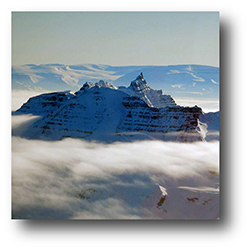 Investigating the Influence of Sea-Surface Variability on Ice Sheet Mass Balance and Outlet Glacier Behavior using Records from Disko Bugt, West Greenland
Investigating the Influence of Sea-Surface Variability on Ice Sheet Mass Balance and Outlet Glacier Behavior using Records from Disko Bugt, West Greenland
Funding Agency: NSF Office of Polar Programs, Arctic Natural Sciences Program
Collaborators: S. Das (Woods Hole Oceanographic Institution), M. Evans (Wheaton College), and B. Smith (PI, University of Washington)
Funding Period: 2012-2017
Recent changes, including the dramatic speedups of several large outlet glaciers, and increased rates of surface melting, have increased Greenland’s contribution to sea level rise from near zero in the 1990s to a large negative imbalance today. Poor knowledge of the processes driving these changes is one of the main limitations on prediction of future ice sheet contributions to sea level rise. An increasing number of observations point towards the influence of coupled ocean-ice-atmospheric processes in modulating ice sheet mass balance and outlet glacier behavior, but most studies are limited to the past few decades restricting our ability to extrapolate these relationships over longer time periods, given their high inter-annual variability. We propose to further our understanding of ocean-ice-atmosphere interaction around the Jakobshavn Isbrae and Disko Bay region of west Greenland, with a particular focus on the role of sea surface temperature and sea ice variability in modulating past outlet glacier behavior and ice sheet/cap mass balance (snowfall and melt) over the past two centuries. We will reconstruct past environmental conditions in the Disko and Baffin Bay region based on new glaciochemical and stratigraphic records from three 100-m deep ice cores, several firn cores, and geophysical studies from three sites surrounding Disko Bay. Our primary field activities in 2014 included: site reconnaissance on ice caps on Disko Island and Nuussuaq Peninsula and collection of shallow cores at both ice cap sites and on the western Greenland margin (to overlap with the last ~10–30 years of the satellite-era.) Our main ice-coring activity followed in 2015 at all 3 sites where we collected ~100-m deep ice-cores. Our field activities will be followed by extensive lab and computational work to derive climate reconstructions from these cores. These results will complement recent glaciological studies of regional ice dynamic behavior, as well as recent paleoceanographic and glacial geologic reconstructions of conditions from this area and era.
